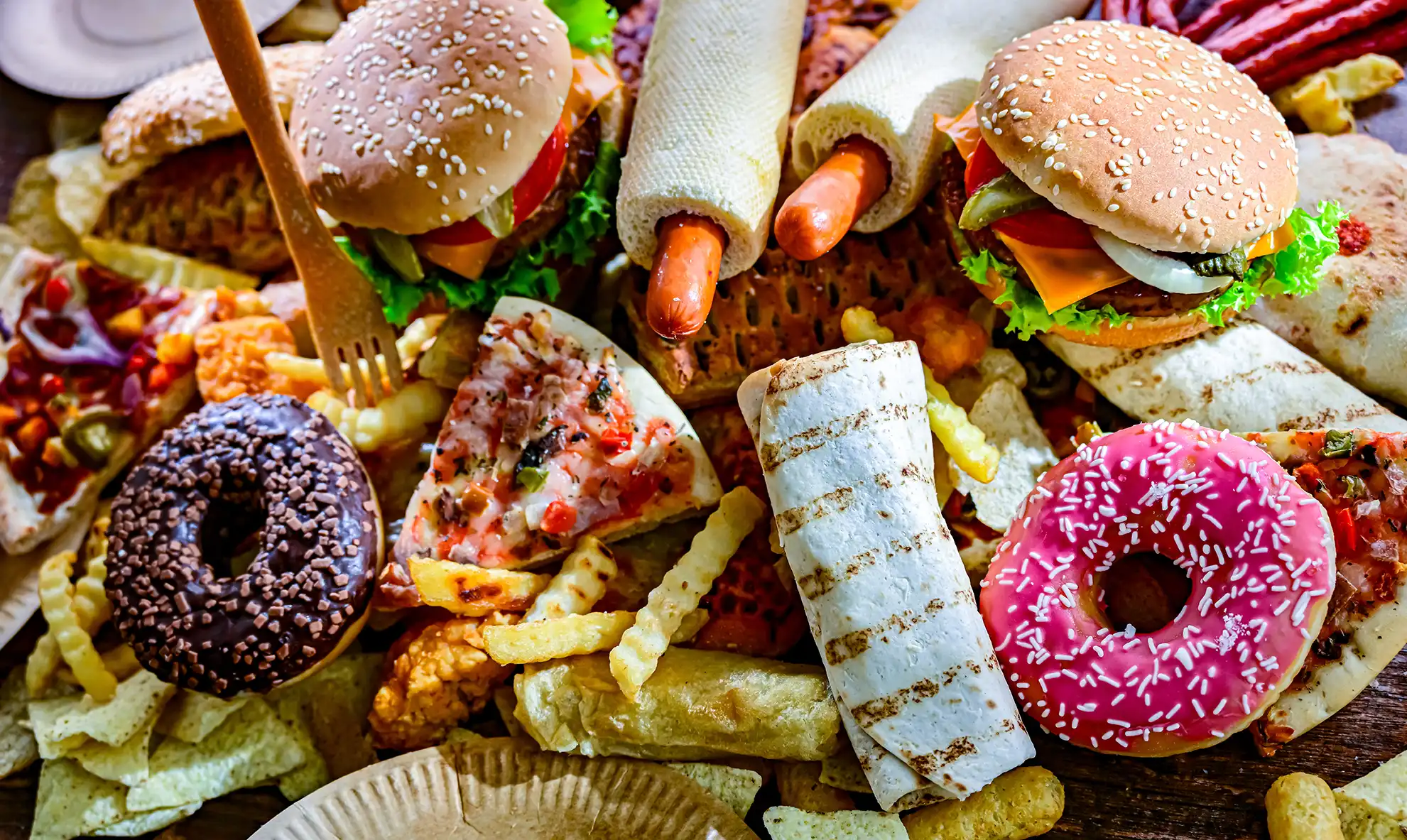Low diet quality is a significant public health problem in the U.S. and is associated with elevated risk of chronic health conditions like heart disease, diabetes and even mortality. Research published in journals like Diabetes Care and the New England Journal of Medicine underscores the critical need to address dietary behaviors to reduce disease burden and improve population health outcomes.
While ultra-processed foods – think packaged snacks, frozen meals and hot dogs – have become dietary staples due to their convenience, affordability and aggressive marketing, health experts are emphasizing the importance of educating the public about the impact these kinds of foods have on the body. Food scientists and policymakers want to influence diet changes through relatable, actionable health communication strategies that are tailored to consumer needs.
An assortment of ultra-processed foods, including chips, cookies and candy, highlighting the convenience and prevalence of these items in modern diets.
“Experts don’t necessarily agree on the definitions of processed foods, wrote ORAU health education specialist and nutritionist, Diane Krause, MS-MPH, CPH, RDN, and former ORAU employee Kristin Mattson, MPH, MCHES, in their white paper, Insights from Social Media Conversations on X about Ultra-Processed Foods and Recommendations for Health Communications.” (.PDF) This lack of consensus complicates efforts to develop consistent and effective health communication messages for the public.”
As part of its “Make America Healthy Again” (MAHA) initiative, the U.S. Department of Health and Human Services has announced plans for a public marketing campaign focused on ultra-processed foods and their link to diabetes.
The power of social listening

Diane Krause, MS-MPH, CPH, RDN, ORAU health education specialist and nutritionist
Krause and Mattson write that “effective implementation of such campaigns requires insights into public discourse. Social media platforms provide a unique opportunity to analyze public discourse around health topics and better understand audiences’ knowledge, attitudes, beliefs, and behaviors.”
Krause is an expert in social listening, which involves analyzing online conversations on social media, forums, blogs, and other sites to uncover insights into what people are saying about a specific topic. In this case, Krause and Mattson used Meltwater media intelligence software to analyze social media activity on the platform X about ultra-processed foods.
“Social media platforms provide a unique opportunity to better understand audience knowledge, attitudes, beliefs, and behaviors,” Krause said on a recent episode of Further Together, The ORAU Podcast.
In their analysis, Krause said the two most common themes on social media were conversations offering dietary advice and those focused on policy and legislation.
“The policies and legislation posts often mentioned HHS Secretary Kennedy (Robert F. Kennedy, Jr.). These posts had the highest engagement across different categories, meaning they had the most likes, comments, and shares,” she said. “And then the dietary advice posts shared tips for healthier eating, but they were often missing evidence-based information, so that was an important finding.”

ORAU experts used Meltwater media intelligence software to analyze stated opinions about ultra-processed foods on social media.
Krause added that federal, state, and local health agencies had almost no presence in social media discussions about processed foods. “There’s a need for scientifically accurate information in this space, so that was important to note,” she said.
People want to make better choices but don’t always know how
Additionally, Krause said people use the terms “processed foods” and “ultra-processed foods” without defining them or providing examples, which happens in public conversations as well, but there is confusion about what the terms mean.
So, let’s define them:
- Processed Food:
- Processed foods are whole foods that have been altered from their natural state for preservation, convenience or taste enhancement. This includes techniques like freezing, canning, drying, or adding salt, sugar or oil. Examples include canned vegetables, frozen fruits and cheese. These foods often retain most of their nutritional value.
- Ultra-Processed Food:
- Ultra-processed foods go beyond basic processing and are industrial formulations made primarily from food-derived substances, additives and artificial ingredients. They often contain little to no whole food and are designed for convenience, flavor enhancement and long shelf life. Examples include soft drinks, packaged snacks, instant noodles, and candy. These foods typically have lower nutritional value and higher levels of sugar, salt, unhealthy fats, and additives.
Despite the confusion, social media users have strong opinions about ultra-processed foods, which Krause said was a bit of a surprise because healthy eating often takes a backseat in American priorities.
Social media platforms offer unique opportunities to analyze public attitudes, beliefs and behaviors regarding food.
“When we analyzed our sample posts, we found that the majority, about 80%, were opposed to ultra-processed foods while the remaining 20% were neutral,” Krause said. “More research needs to be done in this area, but this suggests there may be significant public interest in reducing consumption of these industrial foods.”
There is also a tremendous need to educate people about healthy alternatives to ultra-processed foods, Brenda Blunt, ORAU senior director for Health and Resiliency Strategy, told Further Together, The ORAU Podcast. People “need to know what the other options are,” she said.

Brenda Blunt, ORAU senior director for Health and Resiliency Strategy
ORAU can help make change happen
Blunt sees a great opportunity to partner with agencies, foundations, and other organizations that want to drive the change toward healthier eating.
“Together, we can help develop the impactful messaging and education materials that meet people where they are and to ensure that the information is relatable and actionable for them,” Blunt said. “We have to be able to craft the messaging and the educational materials to meet people where they are.”
Meeting people where they are is critical, said Jennifer Reynolds, ORAU senior manager of public health. “We say in public health, if you’re talking to everyone, you’re talking to no one, right?” adding that messages need to be tailored to the audience you want to reach.

Jennifer Reynolds, ORAU senior manager of public health
ORAU has been a leader in helping our clients gather information about the groups they want to reach.
“We regularly conduct formative research studies, both qualitative – applying methods like interviews and focus groups – and quantitative – doing surveys of large magnitude and secondary data analysis,” Reynolds said.
Barriers to change
There are significant barriers to overcome to get more people to eat healthier, both Blunt and Reynolds said.
- Food is cultural. “Each of us within our family systems, within our cultural systems have a lot of patterns and opinions and beliefs about food,” Reynolds said, adding that ORAU understands cultural competency and how culture affects how messages are developed and received.
- Access is not equal. “Not everyone has readily available access to healthy food. We have food deserts. We have inflation that is making it really challenging for folks to purchase healthy foods at the grocery store.
- Change isn’t easy. “We can say you just need to choose healthier options or you need to reduce your reliance on processed foods, but if you don’t know what that means or how to do it, you’re stuck,” Blunt said.
- System change is required. While it may be true that individuals need to make changes to what and how they eat, there are systemic changes that need to take place. Manufacturers are starting to change some of what they’re putting in foods; government agencies like HHS, the U.S. Department of Agriculture, state and local health departments, and foundations and non-profits need to work together to drive change at the national level, Blunt said.

Krause said she hopes the white paper will serve as a valuable resource for professionals working toward the system change Blunt talked about.
“It would be great to see federal and state agencies, nonprofits and other organizations fund more research and launch communications campaigns around ultra-processed foods. And we encourage health practitioners like healthcare providers, nutrition professionals, and school leaders to use the insights to help people make informed nutrition choices and improve systems and overall health,” she said.
ORAU’s Health and Resiliency Strategy team stands ready to help these organizations and individuals develop meaningful and impactful messaging to reach their respective audiences.
From Further Togther, the ORAU podcast: Insights into ultra-processed foods gained from social listening: A conversation with ORAU subject matter experts
Ultra-processed foods – think packaged snacks, frozen meals and hot dogs – have become dietary staples due to their convenience, affordability and aggressive marketing. However, these foods have low to no nutritional value and can contribute to significant health issues like obesity, diabetes, heart disease and colorectal cancer. In this episode of Further Together, three of ORAU’s subject matter experts – Diane Krause, Brenda Blunt and Jennifer Reynolds – talk about a recently published white paper on social listening and perceptions of ultra-processed foods. Improving diet quality is a critical goal of the Make America Healthy Again Agenda promulgated by Robert F. Kennedy, Jr., U.S. Health and Human Services secretary. Our experts talk in detail about the white paper and what their findings mean for future research and policy initiatives.
